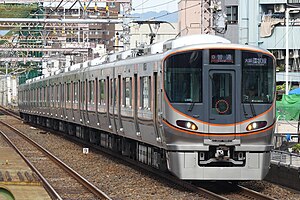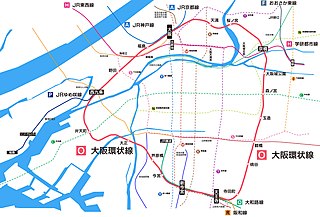|
Osaka Loop Line
The Osaka Loop Line (大阪環状線, Ōsaka kanjō-sen) is a railway loop line in Japan operated by the West Japan Railway Company (JR West). It encircles central Osaka. Part of a second, outer loop line, the Osaka Higashi Line, from Hanaten to Kyuhoji was opened on March 15, 2008, and the line from Shigino to Shin-Ōsaka opened in March 2019. This entry covers the original central loop line. OutlineThe loop line consists of two tracks around the heart of metropolitan Osaka. All train services consist of eight cars, with distinctive orange color with white JR graphics on the front, rear and sides. The train schedule varies, but on average, two trains leave Tennōji Station and Ōsaka Station every five minutes, in opposite directions. Operation
On this line, JR West operates several types of trains. The line serves as a link between Ōsaka Station in northern Osaka (actually the Umeda district), and Tennōji in southern central Osaka. Some Limited Express trains linking north and south of the Osaka–Kobe–Kyoto area use the line as a bypass between the Tōkaidō Main Line in the north and the Hanwa Line in the south. Traffic is heavier in the eastern half, Osaka–Kyōbashi–Tennōji, than in the western half via Nishi-Kujō. DirectionThe completely loop shaped Osaka Loop Line is unable to use the "up" (上り, Nobori) and "down" (下り, Kudari) rail direction convention usually applied to JR lines. Instead, the words "outer loop" (running clockwise) (外回り, Soto mawari) and the "inner loop" (running counter-clockwise) (内回り, Uchi mawari) are used to refer to the direction of the train, similar to the Yamanote line in Tokyo. For purposes of rail registration of the line at the Ministry of Land, Infrastructure, Transport and Tourism,[2] the inner loop is considered "down". LocalLocal trains are operated all day. Some operate over the complete loop, while some serve the eastern half between Osaka and Tennōji via Kyōbashi. Eight-car EMUs of 323 series are used. 221 series, 223 series and 225 series are used only for morning rush. Sakurajima Line trainsTrains of the Sakurajima Line (JR Yumesaki Line) are now operated through to the loop line to/from Kyōbashi and Tennoji. Eight-car 323 series EMUs are used. Rapids of Kansai Main LineThrough trains to the Kansai Main Line (Yamatoji Line) began operated in 1973. "Yamatoji Rapid" (大和路快速, Yamatoji Kaisoku) and "Regional Rapid" (区間快速, Kukan Kaisoku) trains originate at Tennōji on the loop, passing the loop as "inner" via Osaka, and after stopping at Tennōji after a complete circuit, exit the loop onto the Kansai Main Line and terminate at Kamo, Nara or Ōji. In the loop, Yamatoji Rapids pass some stations while Regional Rapids stop all. For "Yamatoji Rapid" and "Regional Rapid", usually 8-car and 4+4 car 221 series EMUs are used. Rapids of Hanwa LineTrains to the Hanwa Line, "Kansai Airport Rapid" (関空快速, Kankū Kaisoku) for Kansai Airport and Kishūji Rapid (紀州路快速, Kishūji Kaisoku) for Wakayama originate at either Tennoji or Kyobashi, and together with other types of rapid trains, operate on the inner loop via Osaka, pausing at Tennoji and then exiting from the loop. This pattern commenced in 1989, but increased significantly in 1994 on the opening of Kansai Airport. 8-car 223 series and 225 series EMUs in 4+4 formations are used for Kansai Airport and Kishūji rapids. 113 series 4-car units were used for rapids of Shin-Ōsaka - Kii-Tanabe in early morning and late night. They were withdrawn in 2010. Limited expressCharged Limited Express services such as Haruka for Kansai International Airport, and south bound Kuroshio on the Hanwa Line and Kisei Main Line (Kinokuni Line) heading for the scenic southern Wakayama Prefecture utilize the Osaka Loop Line to bypass the Tōkaidō Main Line and reach the Hanwa Line. On the loop, aside from Tennōji, limited numbers of trains stop only at Nishi-Kujō. Between the Tōkaidō Main Line and the Osaka Loop Line, trains utilize the Umeda Freight Line via a new underground route through Ōsaka Station, until it merges the main line at Shin-Ōsaka. This route was introduced in 1989 on the completion of a bypass track from the Hanwa Line to platforms of the Kansai Main Line at Tennōji. Until then no through operations were possible from the Hanwa Line. 281 series and 271 series EMUs are used for Haruka, 283 series EMUs, 287 series EMUs and 289 series EMUs for Kuroshio. Freight trainsAfter the abandonment of the Naniwa freight terminal, freight trains on the line operate only between Fukushima and Nishikujō, from the "Umeda Freight Line" to Ajikawaguchi on the Sakurajima Line (JR Yumesaki Line). StationsListed counterclockwise: All stations are in the city of Osaka, Osaka Prefecture. Stopping patterns
Rolling stockLocal
The first of a fleet of 21 new 323 series eight-car EMU trains were introduced from 24 December 2016, scheduled to entirely replace the fleet of 23 103 and 201 series trains by 2018.[3] As of December 2021, few of the remaining 103 series (from Nara Line) and 201 series (Osaka Higashi & Yamatoji Line) continue to be used on the Loop Line. Yamatoji Rapid, Regional RapidKansai Airport Rapid, Kishūji Rapid, Direct Rapid and Local
Limited express
FreightLocomotives seen hauling freight trains include the M250 series, EF65, EF66, EF81, EF210 and DE10. FormerPassenger
FreightFaresA special discount rate is applied for travels within the Osaka Loop Line, the Sakurajima Line and the segment between JR Namba Station and Tennōji Station of the Kansai Main Line (collectively called the Osaka Loop Zone (大阪環状線内, Ōsaka Kanjōsen-nai)). The following table is the rate for adult single-ride tickets.[6] (Note: Fractions of one kilometre are rounded up to the nearest full kilometre.)
For travel between a station within the zone and a station out of the zone or between two stations out of the zone, fares are calculated in accordance with a universal fare table and the discount rate as above is not applicable. For the calculation of the fare for travel between two stations out of the zone that includes the segment between Ōsaka Station and Tennōji Station of the Osaka Loop Line, where two routes (10.7 km or 6.6 mi route via Temma and 11.0 km or 6.8 mi route via Fukushima) are practical, the shorter route is always used irrespective of the actual travel route.[7][8] HistoryThe Ōsaka Loop Line consists of four segments, namely:
Jōtō LineThe Ōsaka to Tennōji via Kyōbashi section (the eastern half of Osaka Loop Line) was opened by the Osaka Railway (大阪鉄道, Osaka Tetsudō) (which also opened the present Minami Osaka Line network) to link it to the Japanese Government Railway (JGR) network in 1895. The line was opened in 2 stages: Tennōji – Tamatsukuri (2 mi. 28 chain, ca. 3.8 km) on 28 May; and Tamatsukuri – Umeda (4 mi. 29 chain, ca. 7.0 km) on 17 October. Earlier, in 1889, the company opened its main line from Kashiwara – Tennōji – Minatomachi (湊町, present JR Namba) which includes a short section of the Osaka Loop Line, being Tennōji – Imamiya; Imamiya station itself, located between Tennōji and Minatomachi, was opened in 1890. The Osaka Railway merged with the Kansai Railway (関西鉄道, Kansai Tetsudō, also read as Kansei or Kwansai) in 1900, creating a single entity for the line from Tennōji Station to JGR Ōsaka Station. The Kansai Railway was acquired by the national government in 1907 under the 1906 Railway Nationalization Act. In 1909 the line was named the "Jōtō Line" (城東線, Jōtō sen). In 1930, distrances were changed to metric, thus the distance changed from 6.6 miles. to 10.7 km. Electrification of the Jōtō Line was commissioned in 1933. Nishinari LineThe Osaka to Nishi-Kujō section (the northwestern quarter of the line) was built by the Nishinari Railway (西成鉄道, Nishinari Tetsudō) to provide rail access to the Osaka Port. In 1898, the company opened the Osaka – Ajikawaguchi line, which was leased to JGR in 1904. In 1906 the company was nationalized under the act of the same year. In 1909, the line was named the "Nishinari Line" (西成線, Nishinari sen) which included the present-day Sakurajima Line. The Nishinari Line was electrified in 1941. Kansai Main Line Freight LineThe Tennōji to Sakaigawa Signal Box (between Taishō and Bentenchō, closed in 2006 when the branch to the port closed) section (south-western portion of the loop) was constructed for freight traffic by the JGR to the port area in 1928, connecting to a freight branch line of the Kansai Main Line, Imamiya – Naniwa (浪速) – Osaka-minato (大阪港, apart from the present Ōsakakō Station on the Osaka Municipal Subway Chūō Line) with a distance of 5.2 mi. (ca. 8.4 km). In 1930 with the change to metric measurement, it became 8.2 km. The former Osaka-Minato and Osaka-Tōkō stations were closed in 1984. Purpose-built loop line sectionTo complete the Loop Line, new tracks were constructed between Nishi-Kujō and Sakaigawa Signal Box by the then Japanese National Railways. In 1961, this section opened and the new Osaka Loop Line was named for the entirety of the then Jōtō Line, Osaka – Nishi-Kujō section of the Nishinari Line (the rest, Nishi-Kujō – Sakurajima was named the Sakurajima Line) and the new Nishi-Kujō – Taishō – Tennōji section. In 1964, operation as a complete Loop Line commenced with the opening of elevated double tracks around Nishi-Kujō. Until then the operation had been undertaken in the shape of a mirrored "6", Sakurajima – Nishi-Kujō – Osaka – Kyōbashi – Tennōji – Nishi-Kujō. The Tennōji – Shin-Imamiya section was quadrupled in 1968, to separate operations from the Kansai Main Line. See alsoReferencesThis article incorporates material from the corresponding article in the Japanese Wikipedia
|
||||||||||||||||||||||||||||||||||||||||||||||||||||||||||||||||||||||||||||||||||||||||||||||||||||||||||||||||||||||||||||||||||||||||||||||||||||||||||||||||||||||||||||||||||||||||||||||||||||||||||||||||||||||||||||||||||||||||||||||||||||||||||||||||||||||||||||||||||||||||||||||||||||||||||||||||||||||||||||||||||||||||||||||||||||||||||||||||||||||||||||||||||||||||||||||||||||||||||||||||||||||||||||||||||||||||||||||||||||||||||||||||||||||||||||||||||||||||||||||||||||||||||||||||||||||||||||||||||||||||||||||||||||||||||||||||||||||||||||||||||||||||||||||||||||||||||||||||||||||||||||||||||||||||||||||||||||||||||||||||||||||||||||||||||||



